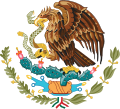History
Historically, both nations were host to great indigenous cultures; the Aztecs and Mayas in Mexico and the Incas in Peru. During colonization, both nations were part of the Spanish Empire until the early 19th century. Mexico was part of Viceroyalty of New Spain while Peru was part of the Viceroyalty of Peru. Diplomatic relations between Mexico and Peru were established on 23 January 1823, [3] two years after Peru gained its independence from Spain. [1] In October 1892, Mexico opened its first consulate in Lima followed by the opening of an embassy on 14 June 1937. [1]
In 1932, a Peruvian newspaper published a letter by Peruvian politician Víctor Raúl Haya de la Torre where he talks about wanting to establish different styles of governing in Latin America. The letter was addressed to a colleague and states the plan in detail to another friend who he sent a letter (but never arrived) via a Mexican diplomatic pouch to Lima. [4] This letter caused such an outrage in Peru that the government accused the Mexican government of 'meddling' in its internal affairs and severed diplomatic relations with Mexico. Diplomatic relations were once again restored in 1933 with the incoming of a new president in Peru. [4]
In 1960, President Adolfo López Mateos was the first highest ranking Mexican official to visit Peru, followed by President Luis Echeverría in 1974. It was not until the 1990s that Peruvian Presidents Alan Garcia and Alberto Fujimori paid official visits to Mexico. Since then, there have been a continuous flow of official visits by both nations to each other's countries, respectively. [1]
In 2012, both nations became founding founders of the Pacific Alliance (along with Colombia and Chile). In July 2016, Mexican President Enrique Peña Nieto attended the inauguration of President Pedro Pablo Kuczynski. In December 2018, Peruvian President Martín Vizcarra attended the inauguration of President Andrés Manuel López Obrador.
In December 2022, López Obrador revealed that Peruvian President Pedro Castillo intended to request political asylum following the backlash to Castillo's attempted self-coup. [5] Castillo was arrested before reaching the Mexican Embassy in Lima. [5] On December 20, the family of former President Castillo was granted asylum and flown to Mexico. The Mexican ambassador in Lima was declared "persona non grata" and ordered to leave Peru. [6] In February 2023, Peruvian President Dina Boluarte withdrew the ambassador of Peru in Mexico. [7] In May 2023, the Peruvian Congress declared Mexican President Andrés Manuel López Obrador persona non grata citing "his meddling in Peru's internal affairs and marking a deepening diplomatic split in the region". [8] President López Obrador has also refused to hand over the presidency of the Pacific Alliance to Peru as the Mexican Government refuses to recognize President Boluarte and her Government since the removal of President Pedro Castillo, however, the presidency was passed on to Boluarte by Chilean President Gabriel Boric in 2023. [9]
In April 2024, Mexico's Secretariat of the Interior announced that it will return to asking visas for Peruvian citizens entering the country, arguing that there has been an increase in the influx of Peruvian citizens trying to illegally cross the Mexican border to the United States. [10] Mexico had previously stopped asking visas for Peruvian citizens back in 2012 as an agreement to boost tourism and business between Pacific Alliance members. [11] In response to the unilateral visa resumption, citing reciprocity, the Peruvian Ministry of Foreign Affairs announced that the country will also be asking visas for Mexican citizens entering the country. [12] However, four days later, Peru reversed its stance and decided to repeal the official decree imposing visas for Mexican citizens, mostly due to concerns from local business unions about the measure's impact on the tourism sector. [13] [14]
On November 3, 2025, Peru made the decision to break relations with Mexico after Betssy Chávez sought asylum inside the Mexican embassy in Lima. [15] Both countries will retain consular and trade relations. [16]
Trade relations
On 1 February 2012, a free trade agreement between the two nations came into effect. [28] In 2023, two-way trade between both nations amounted to US$2.7 billion. [29] Mexico's main exports to Peru include: flat screen TVs; tractors for semi-trailers; shampoos; corrugated bars; silver minerals; electronics and automobiles. Peru's main exports to Mexico include: natural gas; minerals from copper; tomato; calamari; boxes, crates and cages; lead minerals; chilies sweets or peppers; tables, planks and beams. [29]
Several Mexican multinational companies such as América Móvil, Cinépolis, FEMSA, Grupo Bimbo, Grupo México, Grupo Salinas, Orbia, Oxxo and Sigma Alimentos (among others) operate in Peru. Peruvian multinational company Ajegroup (Kola Real) operates in Mexico. In 2022, Mexican companies invested US$16 billion in Peru. [30] Mexico is Peru's third largest trading partner in Latin America (after Brazil and Chile). [30]
This page is based on this
Wikipedia article Text is available under the
CC BY-SA 4.0 license; additional terms may apply.
Images, videos and audio are available under their respective licenses.








